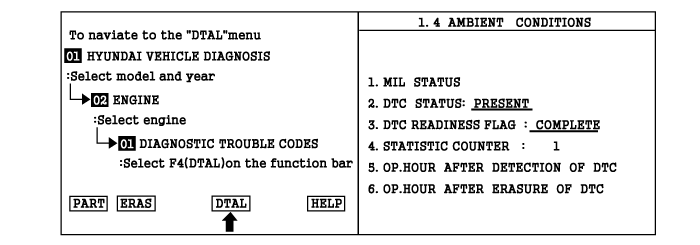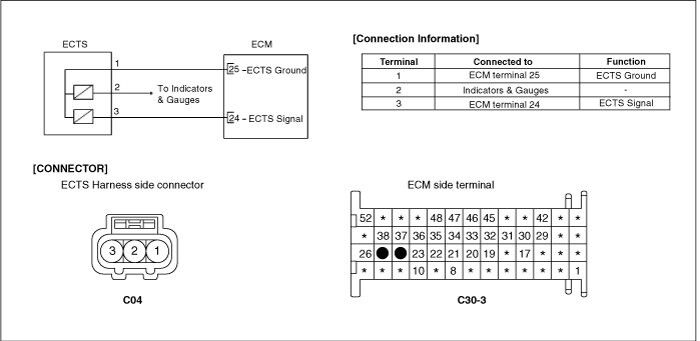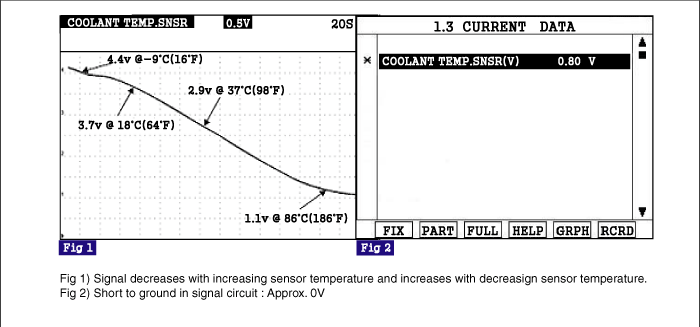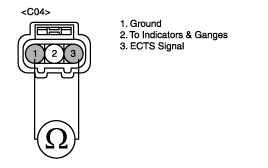Read "DTC Status" parameter.


The Engine Coolant Temperature Sensor (ECTS) is located in the engine coolant passage of the cylinder head for detecting the engine coolant temperature. The ECTS uses a thermistor whose resistance changes with the temperature. The electrical resistance of the ECTS decreases as the temperature increases, and increases as the temperature decreases. The reference 5 V in the ECM is supplied to the ECTS via a resistor in the ECM. That is, the resistor in the ECM and the thermistor in the ECTS are connected in series. When the resistance value of the thermistor in the ECTS changes according to the engine coolant temperature, the output voltage also changes.
During cold engine operation the ECM increases the fuel injection duration and controls the ignition timing using the information of engine coolant temperature to avoid engine stalling and improve drivability.
ECM sets DTC P0117 if the ECM detects signal voltage lower than the possible range of a properly operating ECTS.
ITEM | DETECTING CONDITION | POSSIBLE CAUSE |
DTC Strategy | ● Voltage range check | ● Short to ground in signal harness ● Contact resistance in connections. ● Faulty ECT sensor |
Enable Conditions | ● Engine coolant 〉20℃ (68℉) ● After 100~1000 seconds from engine start | |
Threshold Value | ● Measured coolant temperature > 138℃(280℉). | |
Diagnostic Time | ● 5 sec. |
Temperature | Resistance (kΩ) | Temperature | Resistance (kΩ) | ||
(℃) | (℉) | (℃) | (℉) | ||
-20 | -4 | 14.13~16.83 | 40 | 104 | 1.15 |
0 | 32 | 5.79 | 60 | 140 | 0.59 |
20 | 68 | 2.31~2.59 | 80 | 176 | 0.32 |


Connect scan tool and select "Diagnostic Trouble Codes(DTCs)" mode.
Press F4(DTAL) to select DTC information from the DTCs menu.
Confirm that "DTC Readiness Flag" indicates "Complete". If not, drive the vehicle within conditions noted in the freeze frame data or enable conditions.
Read "DTC Status" parameter.

Is parameter displayed "History(Not Present) fault"?
History (Not Present) fault : DTC occurred but has been cleared.
Present fault : DTC is occurring at present time.

▶ Fault is intermittent caused by poor contact in the sensor's and/or ECM's connector or was repaired and ECM memory was not cleared. Thoroughly check connectors for loose or poor connection, bending, corrosion, contamination, deterioration, or damage. Repair or replace as necessary and go to "Verification of Vehicle Repair" procedure.

▶ Go to "Monitor Scantool Data" procedure.
Ignition "ON" & Engine "OFF".
Disconnect ECTS connector.
Connect Scantool and monitor the "COOLANT TEMP. SNSR(V)" parameter on the Scantool data list.
Specification : Approx. 5V

Is ECTS parameter within the specification?

▶ Possibility of sensor malfunction. Go to "Component Inspection" procedure.

▶ Possibility of signal circuit short to ground. Go to "Signal Circuit Inspection" procedure.
Ignition "OFF".
Measure resistance between terminal 3 of the ECT sensor harness connector and chassis ground.
Specification : Infinite

Is resistance within the specification?

▶ Go to "Terminal and Connector Inspection" procedure.

▶ Repair short to ground in harness and go to "Verification of Vehicle Repair" procedure.
Many malfunctions in the electrical system are caused by poor harness(es) and terminals. Faults can also be caused by interference from other electrical systems, and mechanical or chemical damage.
Thoroughly check connectors for looseness, poor connection, bending, corrosion, contamination, deterioration, or damage.
Has a problem been found?

▶ Repair as necessary and go to "Verification of Vehicle Repair" procedure .

▶ Go to "Component Inspection" procedure.
Disconnect ECTS connector
Measure resistance between terminals 1 and 3 of the ECT sensor connector (Component side)
Specification :
Temperature | Resistance (kΩ) |
-20℃ (-4℉) | Approx. 14.13~16.83 |
20℃ (68℉) | Approx. 2.31~2.59 |
80℃ (176℉) | Approx. 0.32 |

Is resistance within the specification?

▶ Check for poor connection between ECM and component: backed out terminal, improper mating, broken locks or poor terminal to wire connection. Repair as necessary and go to "Verification of Vehicle Repair" procedure.

▶ Check ECTS for contamination, deterioration, or damage. Substitute with a known-good ECTS and check for proper operation. If the problem is corrected, replace ECTS and then go to "Verification of Vehicle Repair" procedure.
After a repair, it is essential to verify that the fault has been corrected.
Connect scan tool and select "Diagnostic Trouble Codes(DTCs)" mode.
Press F4DTAL) and confirm that "DTC Readiness Flag" indicates "Complete". If not, drive the vehicle within conditions noted in the freeze frame data or enable conditions .
Read "DTC Status" parameter.
Is parameter displayed "History(Not Present) fault"?

▶ System performing to specification at this time. Clear the DTC.

▶ Go to the applicable troubleshooting procedure.